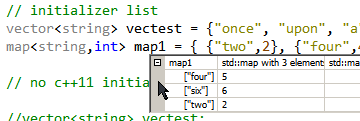Difference between revisions of "Pretty Printers"
Obfuscated (talk | contribs) |
m (add a new stub for pretty printer for msys2) |
||
| Line 46: | Line 46: | ||
</ol> | </ol> | ||
<ol><span style="font-size: 10pt"><tt>Codeblocks->Settings->Debugger->Default->Enable Watch Scripts = Unchecked</tt></span></ol> | <ol><span style="font-size: 10pt"><tt>Codeblocks->Settings->Debugger->Default->Enable Watch Scripts = Unchecked</tt></span></ol> | ||
| + | |||
===Other Info=== | ===Other Info=== | ||
Links: | Links: | ||
| Line 59: | Line 60: | ||
* [[Debugging with Code::Blocks]] | * [[Debugging with Code::Blocks]] | ||
* [[Debugger scripts]] | * [[Debugger scripts]] | ||
| + | * [[Configure GDB pretty printer for Msys2]] | ||
Latest revision as of 11:36, 20 March 2021
GDB Pretty Printers for STL display nicely formatted variables in the hover pop-up and watch window, for all STL containers (vectors, maps, etc).
Test with GDB
- Ensure GDB is python-enabled. For Linux (tested with recent Ubuntu), it is enabled by default. For Windows, MinGW's GDB is not python enabled. One option is to install MinGW-Builds over MinGW (consider backing up MinGW first). This updates GCC to 4.7.2 and includes a Python enabled GDB.
-
To test, launch GDB from console:
(gdb) python print sys.version
If python is enabled, the version will be printed (probably 2.7.x), otherwise, a message will indicate python scripting is not supported.
- Download printers.py (if necessary)
- Windows users with MinGW should already have this file in /MinGW/share/gcc-4.7.2/python/libstdcxx/v6.
- Linux users can download printers.py here. Save as /home/username/gdb_printers/printers.py.
- Create a GDB Command File to enable the printer. Store in c:\mingw\bin\pp.gdb (windows) or /home/username/gdb_printers/pp.gdb (linux). Below is a sample command file. Replace the path c:/MinGW/share... with your path to printers.py.
python import sys sys.path.insert(0, 'c:/MinGW/share/gcc-4.7.2/python/libstdcxx/v6') from printers import register_libstdcxx_printers register_libstdcxx_printers (None) end
- Test
- Set a breakpoint in a program and debug
- Run the command file from GDB (can use Codeblocks->debugger tab->command, or in GDB from the console) (substitute your path if necessary)
(gdb) source c:\MinGW\bin\pp.gdb
- Test the printer - example:
(gdb) print words2
$1 = std::vector of length 3, capacity 4 = {"one", "two", "three"}
Add to Codeblocks
Once the command file is working correctly, there are two steps to activate in Codeblocks:
- Set debugger initialization command (substitute your path as necessary):
Codeblocks->Settings->Debugger->Default->Debugger initialization commands
source c:\MinGW\bin\pp.gdb
NOTE: A bug in the Linux version of Codeblocks may prevent entering anything in the Debugger Initialization Commands field. A work-around is to open a CBP project file via a file manager, which in turn launches Codeblocks and seems to resolve the issue.
- Disable Codeblocks handling of watch values (needed only for versions older than 17.12):
- Codeblocks->Settings->Debugger->Default->Enable Watch Scripts = Unchecked
Other Info
Links:
To Do
The third column in the Codeblocks popup and watch window displays a long unformatted string. Codeblocks is calling the GDB whatis command. Can this command be Pretty-Printed?
